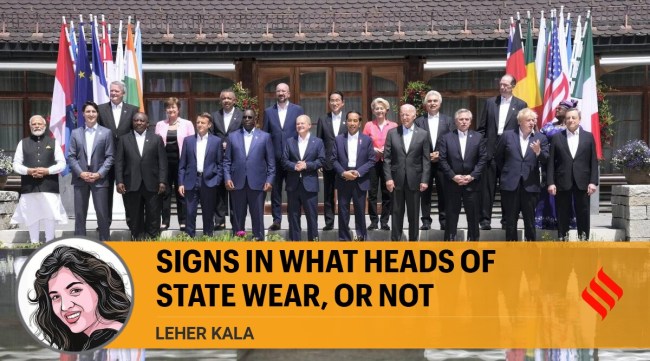Opinion Signs in what heads of state wear, or not
Leher Kala writes: At this depressing time of beheadings, war and mass shootings, we could all do with a little levity.
 U.S. President Joe Biden, front fourth right, waves as he poses with G7 leaders and Outreach guests for an official group photo at Castle Elmau in Kruen, near Garmisch-Partenkirchen, Germany, on Monday, June 27, 2022. (AP)
U.S. President Joe Biden, front fourth right, waves as he poses with G7 leaders and Outreach guests for an official group photo at Castle Elmau in Kruen, near Garmisch-Partenkirchen, Germany, on Monday, June 27, 2022. (AP)
During the G7 summit in Germany held to discuss the devastating invasion of Ukraine, world leaders mocked Russian President Vladimir Putin’s tendency to pose topless for pictures. Putin has been photographed shirtless several times, while fishing, astride a horse, and brandishing a gun. The UK’s Boris Johnson joked that maybe they all should all take their clothes off to “show we’re tougher than Putin”. Canada’s Justin Trudeau can be heard agreeing wryly, that they could match his naked torso with a “bare-chested horseback riding display”. Questioned about the banter, Mr. Putin had the choicest retorts ready, that his counterparts would look “disgusting” stripped down; and a suggestion, that they play sport and drink less alcohol before undressing in public.
To paraphrase Tolstoy, happy people are all alike when it comes to enjoying a chuckle; but unhappy dictators can’t take a joke at their own expense and will react in malicious ways. Being able to laugh at oneself is a worthy quality, and it’s nature’s way, perhaps, that they can’t generally have people laughing at them. Authoritarian figures, especially, don’t have a sense of humour: 80 years ago, Charlie Chaplin was jeering at Hitler in The Great Dictator, who, despite his best efforts, couldn’t stop the film from being a roaring success.
At this depressing time of beheadings, war and mass shootings, we could all do with a little levity. In a sense, it is grotesquely funny that the world is discussing a volatile President’s bare chest, while bombs are raining down and bodies piling up on the streets of Kyiv. Reality comedy — as practised (unwittingly) by these formidable heads of state at the G7—relies on the source behind much laughter, that truth and absurdity tend to go hand in hand.
Let’s face it, no one poses bare-bodied unless they think they are looking absolutely fantastic. For a leader touching 70 to be repeatedly shirtless appears weirdly juvenile to the democratic world because we interpret it as an erratic whim of a megalomaniac. Actually, anyone seeking to rule a country with an iron fist can’t be a thin, weak-looking pushover; sports-loving Russia will relate better (and be more submissive) towards a muscularly intimidating President. Throughout history, attire, or the lack of it, has been used to deliver messages. Instinctively, we know not to wear red to a funeral or tattered jeans to a wedding. On that unforgettable night, November 9, 2016, Hillary Clinton gave her concession speech in a purple Ralph Lauren suit, a salute to bipartisanship (blue plus red equals purple). After Brexit, Queen Elizabeth opened Parliament in a blue and yellow floral dress, the colors of the EU flag, a sign that she disapproved of the ultimate decision. All politicians know that the first step to winning is correctly assessing what their own citizens value.
Contrast Putin’s carefully crafted, Kremlin-approved images conveying proud machismo with those of his foe, Ukrainian president Volodymyr Zelensky, who has shed suits and ties for sombre, olive green or brown T-shirts. Yet, his air of sleepless dishevelment is deeply powerful; it touches a chord with everyone watching, that Ukrainians’ tragic circumstances render the formalities of the polite world utterly meaningless. In our celebrity-obsessed age, we are too easily impressed by symbolisms of power the mighty use to perpetuate their own myths — statues, self-aggrandizing parades or visuals of adulation by teeming crowds. Zelensky’s sartorial stance that appearances be damned keeps the focus on his country’s plight and quietly ridicules the self-obsessed rival showing off his pecs.
Quandaries like what to wear today are the privileges of a secure life. There is plenty to think about watching the conflict in Ukraine, mainly that popular culture wrongly portrays leadership to be white-haired men in sharp, three-piece suits, shaking hands to flashing cameras. Sometimes, it comes in the form of a scruffy young man in a nondescript T-shirt, a sobering reminder that it’s always the wearer who makes clothes remarkable, not the items themselves.
The writer is director, Hutkay Films.




